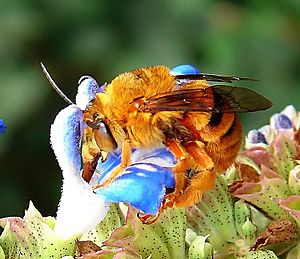Teddy bear bee facts for kids
Quick facts for kids Teddy bear bee |
|
|---|---|
 |
|
| Scientific classification |
The Amegilla bombiformis, often called the teddy bear bee or golden haired mortar bee, is a special bee from Australia. It belongs to the Apidae family, which includes many types of bees.
This bee was first described in 1854 by F. Smith. He named it Saropoda bombiformis. Later, in 1965, it was moved into the group called Amegilla. Its scientific name bombiformis comes from Latin and means "shaped like a bumblebee."
Contents
What Does the Teddy Bear Bee Look Like?
The teddy bear bee is a chunky bee. It really does look a lot like a bumblebee! It's covered in soft, orange-brown fur, which makes it look like a little teddy bear.
Its body has dark, hairless stripes. Male bees have seven of these stripes, while females have six. This bee is about the same size as a common European honeybee.
Where Do Teddy Bear Bees Live?
You can find teddy bear bees in eastern Australia. They live in places like Queensland, New South Wales, and Victoria. They also live in New Guinea and the Aru Islands to the north.
These bees love to visit flowers in gardens. They have been seen on Abelia, Buddleja, and blue flax lily (Dianella caerulea) flowers. At night, male teddy bear bees often rest by holding onto plant stems.
A New Discovery!
In 2017, scientists found a new type of teddy bear bee. This new species was discovered in a small town called Laura, Queensland.
You can tell this new bee apart by the special stripes on its body. Most other bees in this group have fluffy orange-brown fur all over, without clear stripes.
How Do Teddy Bear Bees Build Their Homes?
Teddy bear bees build their nests in the ground. They dig a burrow about 10 centimeters (4 inches) deep. At the end of this burrow, they make several urn-shaped cells.
They often choose places like creek banks or even rubble in gardens. They like spots with some cover overhead. Each cell is about 2 centimeters (0.8 inches) long and has a special waterproof lining.
Inside each cell, the mother bee lays an egg. She also leaves a food supply for the baby bee. This food is a paste made from pollen and nectar.
Meet the Domino Cuckoo Bee
Sometimes, another bee called the domino cuckoo bee (Thyreus lugubris) visits the teddy bear bee's nest. This cuckoo bee is a bit sneaky! It quietly watches the nest.
When the teddy bear bee leaves, the domino cuckoo bee sneaks inside. It lays its own egg in the nest. When the cuckoo bee's baby hatches, it eats the food that was meant for the teddy bear bee's baby.
Why Do Scientists Study Bees?
Scientists are always studying bees to understand them better. In 2010, some researchers looked into why bee colonies sometimes die. They studied teddy bear bees and other Australian bee species.
They found that tiny fungi might be a reason why some bee colonies don't survive. This research helps us learn more about how to protect these important insects.
See also
 In Spanish: Amegilla bombiformis para niños
In Spanish: Amegilla bombiformis para niños

